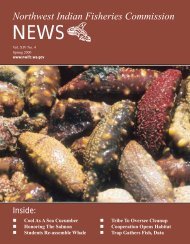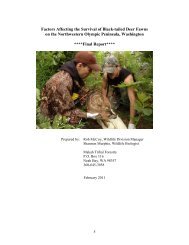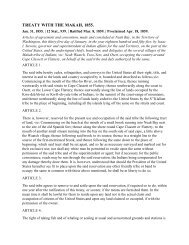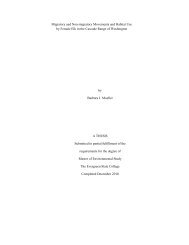Draft TRT Document â for Discussion Purposes ... - NWIFC Access
Draft TRT Document â for Discussion Purposes ... - NWIFC Access
Draft TRT Document â for Discussion Purposes ... - NWIFC Access
Create successful ePaper yourself
Turn your PDF publications into a flip-book with our unique Google optimized e-Paper software.
<strong>Draft</strong> <strong>TRT</strong> <strong>Document</strong> – <strong>for</strong> <strong>Discussion</strong> <strong>Purposes</strong> – OK to circulateproductivity of the river. The size of a basin and the topography and flow of the river tomay also influence homing accuracy. The presence of a seasonal or complete migrationbarrier or barriers provides an added, if not substantial, degree of reproductive isolation.Boundaries between distinct populations could be inferred where rivers diverge intodistinct tributaries or where sizable areas of poor or absent spawning habitat effectivelyseparate spawning areas. Tributary basins, if large enough, may provide ecologicallydistinctive habitats and characteristic homing (olfactory) cues that rein<strong>for</strong>ce theestablishment of independent populations. At a minimum, differences in ecology mayminimize the “attractiveness” of a non-natal stream type. Lawson et al. (2007)considered distance between mouths of independent rivers entering marine waters a veryimportant isolating mechanism.Steelhead in the Puget Sound DPS spawn from the northeast Canadian boundary waters,through south Puget Sound, into Hood Canal, and throughout the Strait of Juan de Fucato, and including, the Elwha River (Figure 1). Many of the contemporary spawningdistributions are well known (WDF et al. 1993, WDFW 2005) in contrast to in<strong>for</strong>mation<strong>for</strong> most basins on the location of present day juvenile rearing areas or historicalspawning distributions. Disjunct spawning areas can suggest discontinuity betweenpopulations, especially where ecological differences or physical barriers coincide withseparations between spawning aggregations. Geographic data on spawning reaches wereavailable <strong>for</strong> only a limited number of rivers; in addition, there is considerable annualvariability in spawner distribution. There<strong>for</strong>e geographic distances (km) separatingspawning areas were defined as the shortest nautical distance separating river mouths(Appendix 3). This measure was considered a conservative estimate of the minimumdistance between presumptive populations. Distances were calculated using networkrouting tools in ESRI's ArcMap and 100k scale NHD (National Hydrography Dataset)streams. The "starting" and "ending" locations (such as river mouths) were used to createa network from the NHD data.The theory of island biogeography (MacArthur and Wilson 1967), when applied tosalmon populations, suggests that a “minimum catchment area” could exist which definesthe minimum watershed area needed to support a self-sustaining steelhead population.Catchment areas <strong>for</strong> major Puget Sound river basins vary by almost two orders ofmagnitude. SaSI populations (WDFW 2005) range from more than 3,946 km 2 <strong>for</strong> theentire Skagit River basin to slightly less than 80 km 2 in the Dewatto River Basin or SnowCreek. Myers et al. (2006) did not establish a minimum catchment area <strong>for</strong> steelhead inthe Lower Columbia River, but speculated that it could be smaller than the 25,000 ha/250 km 2 threshold utilized <strong>for</strong> Chinook salmon DIPs in the Lower Columbia River.16









